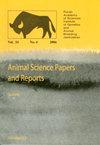肉鸡球虫病防治替代方法的有效性评价:现场试验
IF 1.1
4区 农林科学
Q3 AGRICULTURE, DAIRY & ANIMAL SCIENCE
引用次数: 0
摘要
目前,抗球虫药是家禽养殖场防治球虫病的主要和标准方法。然而,消费者组织仍然指出,有必要逐步淘汰动物营养中的所有化疗物质,以保护人类健康。选用Cobb 500杂交种公鸡720只,分为C -抑球剂/对照组、V -疫苗组和H -草药组。对体重(BW)、饲料系数(FCR)、死亡率、足垫皮炎(FPD)、欧洲生产效率因子(EPEF)和每1g粪便卵囊数(OPG)进行分析。第42天,C组体重高于V组和H组。C组FCR最好,EPEF最高。V组从饲养第14天开始在粪便中发现卵囊,在第21天时卵囊含量最高。C组和H组第28天粪便中卵囊数最多。所研究的抗球虫剂替代方法显示出良好的抗寄生潜力。因此,在预防计划中结合几种抗球虫病方法可能是肉鸡生产的最佳解决方案。本文章由计算机程序翻译,如有差异,请以英文原文为准。
Evaluation of the effectiveness of alternative methods for controlling coccidiosis in broiler chickens: a field trial
Abstract Currently, coccidiostats are the primary and standard method of combating coccidiosis in poultry farms. However, consumer organizations still point to the need to phase out all chemotherapeutic substances from animal nutrition to protect human health. The research material consisted of 720 cocks of the Cobb 500 hybrid, which were divided into three groups (C – coccidiostat/control, V – vaccine, and H – herbals). The following parameters were analyzed: body weight (BW), feed conversion ratio (FCR), mortality, foot pad dermatitis (FPD), European Production Efficiency Factor (EPEF), and the number of oocysts per 1g of feces (OPG). On day 42, the BW of the C group was higher compared with the V and H groups. The C group was also characterized by the best FCR and the highest EPEF. In the V group, oocysts were noted in feces from the 14th day of rearing, and the highest oocysts content was observed on the 21st day of life. In the C and H groups, the highest number of oocysts was recorded in the feces on the 28th day. The investigated alternative methods to coccidiostats showed good antiparasitic potential. Therefore, combining a couple of anticoccidiosis methods in preventive programs may be the best solution in broiler chickens production.
求助全文
通过发布文献求助,成功后即可免费获取论文全文。
去求助
来源期刊

Animal Science Papers and Reports
生物-奶制品与动物科学
CiteScore
1.60
自引率
40.00%
发文量
0
审稿时长
>12 weeks
期刊介绍:
ANIMAL SCIENCE PAPERS AND REPORTS (Anim. Sci. Pap. Rep.) is an English language quarterly published by the Institute of Genetics and Animal Breeding of the Polish Academy of Sciences, Jastrzębiec. Papers are welcome reporting studies in all aspects of animal breeding and genetics, reproduction, animal biotechnology, physiology, ethology and welfare. Critical review papers and short reports will also be considered and in justified cases also other original articles dealing with animal science and production.
 求助内容:
求助内容: 应助结果提醒方式:
应助结果提醒方式:


